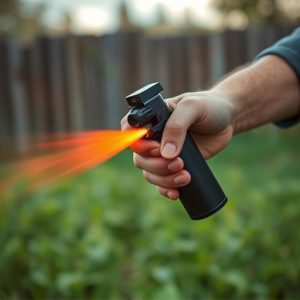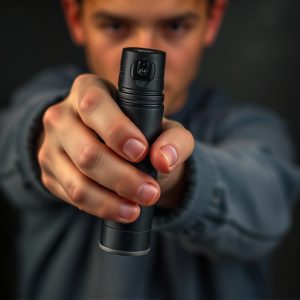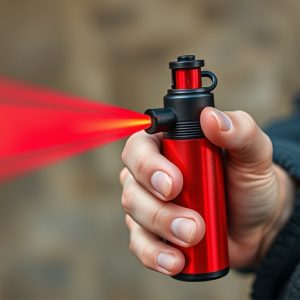Mastering Pepper Spray Decontamination: Steps for Safe Recovery at Home
TL;DR for Pepper Spray Decontamination Steps at Home:After exposure to pepper spray, immediate actio…….
TL;DR for Pepper Spray Decontamination Steps at Home:
After exposure to pepper spray, immediate action is crucial for safety and recovery. At-home decontamination involves moving to fresh air, removing contaminated clothing in sealed bags, rinsing eyes with clean water for 15 minutes, gently washing affected skin areas, and seeking medical help if symptoms persist. Post-decontamination care also includes proper cleaning of living spaces by vacuuming with a HEPA filter and wiping down hard surfaces with damp cloths or sponges. These steps are vital to minimize pepper spray's impact on individuals and prevent cross-contamination.
“In the realm of law enforcement, pepper spray equipment is a vital tool used to control and subdue individuals during critical incidents. This article delves into the intricacies of understanding various types of pepper spray gear and its tactical applications. We explore the significance of proper decontamination procedures after exposure, offering a comprehensive step-by-step guide for effective decontamination at home. Additionally, we provide essential post-decontamination care advice to ensure the well-being of victims.”
- Understanding Pepper Spray Equipment: Types and Usage in Law Enforcement
- The Importance of Proper Decontamination After Pepper Spray Exposure
- Step-by-Step Guide to Pepper Spray Decontamination at Home
- Post-Decontamination Care and Precautions for Pepper Spray Victims
Understanding Pepper Spray Equipment: Types and Usage in Law Enforcement
Pepper spray is a crucial non-lethal tool in the arsenal of law enforcement agencies worldwide. It’s a chemical agent that temporarily incapacitates individuals, providing officers with valuable time to control and subdue suspects. Understanding pepper spray equipment and its proper usage is essential for both safety and effectiveness during law enforcement operations.
There are several types of pepper spray devices designed for various tactical needs. From handheld canisters used by patrol officers to more robust, electric-powered options employed in riot control, each type serves a specific purpose. The decontamination steps after using pepper spray are equally important, especially when it comes to personal safety and minimizing cross-contamination at the scene. Pepper spray decontaminating at home involves simple yet thorough procedures, such as removing contaminated clothing, washing hands and face with soap and water, and cleaning any exposed skin or eyes with a mild solution to prevent irritation and ensure quick recovery.
The Importance of Proper Decontamination After Pepper Spray Exposure
After exposure to pepper spray, proper decontamination steps are crucial for both individuals and law enforcement officers to ensure safety and minimize discomfort. Pepper spray can cause eye irritation, respiratory distress, skin redness, and pain. Therefore, immediate action should be taken to neutralise the effects of the chemical agent.
At-home decontamination involves several simple yet effective steps. First, move to an area with fresh air to prevent inhalation of residual pepper spray. Next, carefully remove any contaminated clothing or footwear, placing them in a sealed plastic bag for proper disposal. Rinse eyes thoroughly with clean water for at least 15 minutes to flush out the irritant. For skin contact, wash the affected areas gently with soap and warm water. Inhaling pepper spray can lead to respiratory distress; if symptoms persist, seek medical attention immediately.
Step-by-Step Guide to Pepper Spray Decontamination at Home
After a confrontation or training session involving pepper spray, properly decontaminating your living space is crucial to ensure safety and maintain a clean environment. Here’s a step-by-step guide on how to decontaminate your home after exposure to pepper spray.
First, remove any clothing that may have been contaminated and place them in a sealed plastic bag for later washing. Next, open all windows and doors to allow fresh air circulation. Use fans or other ventilation systems if available. Move all furniture away from walls and surfaces where the spray might have settled. Vacuum all floors, carpets, and upholstered furniture using a vacuum cleaner equipped with a HEPA filter to capture any remaining pepper spray particles. Lastly, wipe down all hard surfaces like countertops, tables, and doorknobs with a damp cloth or sponge, ensuring you dispose of the cleaning solution used in a safe manner.
Post-Decontamination Care and Precautions for Pepper Spray Victims
After exposure to pepper spray, proper post-decontamination care is crucial to alleviate discomfort and prevent potential health issues. The first step for victims is to immediately seek a safe, well-ventilated area away from the source of the spray. Removing contaminated clothing and washing eyes and skin with plenty of water are essential decontamination steps at home. Rinsing thoroughly can help flush out any residual pepper spray chemicals.
To avoid irritation or potential damage, it’s important to avoid rubbing the affected areas. Using mild soap and warm water for gentle cleaning is recommended. For eye exposure, a clean cloth soaked in cold water can be used to gently wipe away any remaining spray. It is also advisable to stay hydrated by drinking plenty of water to help rinse out the lungs if inhalation occurred. Medical attention should be sought immediately if symptoms persist or worsen.
In conclusion, pepper spray equipment is a critical component of law enforcement tools, but its use necessitates a thorough understanding of decontamination procedures. The proper steps for pepper spray decontaminating at home, as outlined in this article, are essential to mitigate the effects of exposure and ensure victims’ safety and comfort. By following these simple yet effective Pepper Spray Decontamination Steps at Home, law enforcement officers and bystanders alike can promptly address the challenges posed by pepper spray use, fostering a safer environment for all.


